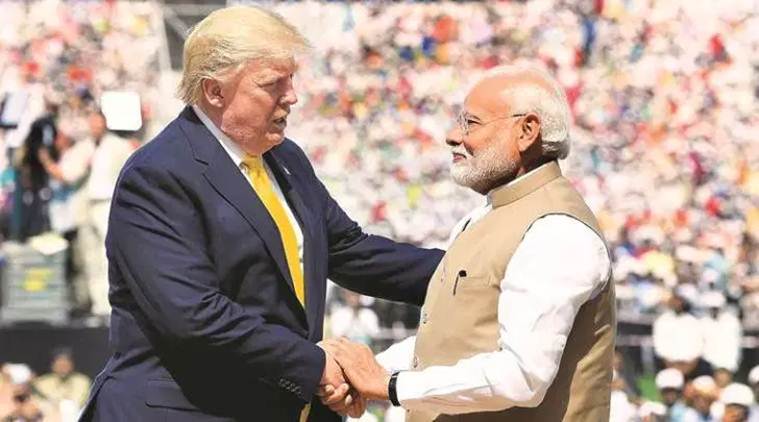
The Indian Express
Day after Trump’s mediation offer, India says engaged with China to peacefully solve LAC issue
Responding to questions on Trump’s offer, Ministry of External Affairs (MEA) spokesperson Anurag Srivastava said, “We are engaged with the Chinese side to peacefully resolve this issue.”
by Shubhajit RoyA day after US President Donald Trump waded into the ongoing tension between India and China on the border incidents, New Delhi said on Thursday that it is engaged with Beijing to “peacefully resolve” the issue.
Responding to questions on Trump’s offer, Ministry of External Affairs (MEA) spokesperson Anurag Srivastava said, “We are engaged with the Chinese side to peacefully resolve this issue.”
On Wednesday, Trump had tweeted, “We have informed both India and China that the United States is ready, willing and able to mediate or arbitrate their now raging border dispute. Thank you!”
Srivastava refrained from addressing Trump’s tweet, and did not reject any third-party mediation, as it had done in the past.
In the past, Trump had offered to mediate between India and Pakistan over Kashmir, but this is the first time he has made such an offer to India and China, referring to the situation along the Line of Actual Control (LAC) as a “raging border dispute”.
On July 22 last year, Trump mentioned for the first time his willingness to “help” and “mediate” between India and Pakistan over Kashmir — an offer that was rejected by the MEA which reiterated New Delhi’s stated position that the issue can only be discussed bilaterally.
Since then, Trump has repeated the offer on Kashmir, with a “if both sides want” rider, about half-a-dozen times, and has been politely told no each time — once even by Prime Minister Narendra Modi on the sidelines of the G-7 summit in Biarritz in France last August.
On the India-China incidents along the LAC, Srivastava said Indian troops have taken a “very responsible approach” towards border management and “strictly follow the procedures”. He said India remains “firm” in its resolve to ensure its “sovereignty and national security”.
This is the third time the MEA has issued a statement on the tension along the India-China border, and has for the second time invoked “sovereignty” and “national security” in the statement. In the May 21 statement, the government had said it is “deeply committed” to ensuring India’s “sovereignty and security”.
“Our troops have taken a very responsible approach towards border management and strictly follow the procedures laid out in various bilateral agreements and protocols with China, to resolve any issue that may arise in the border areas,” he said at the weekly briefing.
He said the two sides have established mechanisms, both at “military and diplomatic” levels, to “resolve situations” which may arise in border areas “peacefully through dialogue” with the objective of “maintenance of peace and tranquility in the border areas with China”.
He also said Indian forces “scrupulously follow the consensus reached by our leaders and the guidance provided”, referring to decisions at Wuhan and Mahabalipuram summits between Prime Minister Narendra Modi and Chinese President Xi Jinping.
While the reference to the leaders’ guidance was missing in the May 21 statement, it was explicitly mentioned in the May 14 statement — the first since the incidents along the LAC took place.
“At the same time, we remain firm in our resolve to ensuring India’s sovereignty and national security,” he said.
For the first time since the LAC incidents took place early May, the MEA also cited the five agreements and protocols signed between the two sides, including the Working Mechanism on Consultation & Coordination on India-China Border Affairs (WMCC) in 2012.
Since 1993, India and China have signed several bilateral agreements and protocols to ensure Peace and Tranquility in the India-China border areas. These include: 1993 Agreement on Maintenance of Peace and Tranquility along the Line of Actual Control in the India-China border areas; 1996 Agreement on Confidence Building Measures in the Military Field along the LAC; 2005 Protocol on Modalities for the implementation of the Confidence Building Measures in the Military Field along the LAC; 2012 Agreement on the establishment of a working mechanism for consultation and coordination on India-China Border Affairs; and 2013 Border Defence Cooperation Agreement.
Srivastava on Thursday said that “our engagement at the diplomatic level also continues between both sides, both in Delhi as well as in Beijing.”
As reported by The Indian Express, India and China are learnt to have activated the “working mechanism” at the diplomatic level — it was established during then Prime Minister Manmohan Singh’s tenure in 2012 and was signed by then Indian ambassador to Beijing, S Jaishankar, now the External Affairs Minister.
This mechanism has been activated, alongside the military-to-military conversation taking place at the field level, to “dis-engage” and “de-escalate” the situation.
In the ‘Working Mechanism for Consultation & Coordination on India-China Border Affairs (WMCC)’, Naveen Srivastava, Joint Secretary (East Asia) in the MEA, leads the Indian side. The Chinese are led by Hong Liang, Director General, Department of Boundary and Oceanic Affairs, Chinese Ministry of Foreign Affairs.